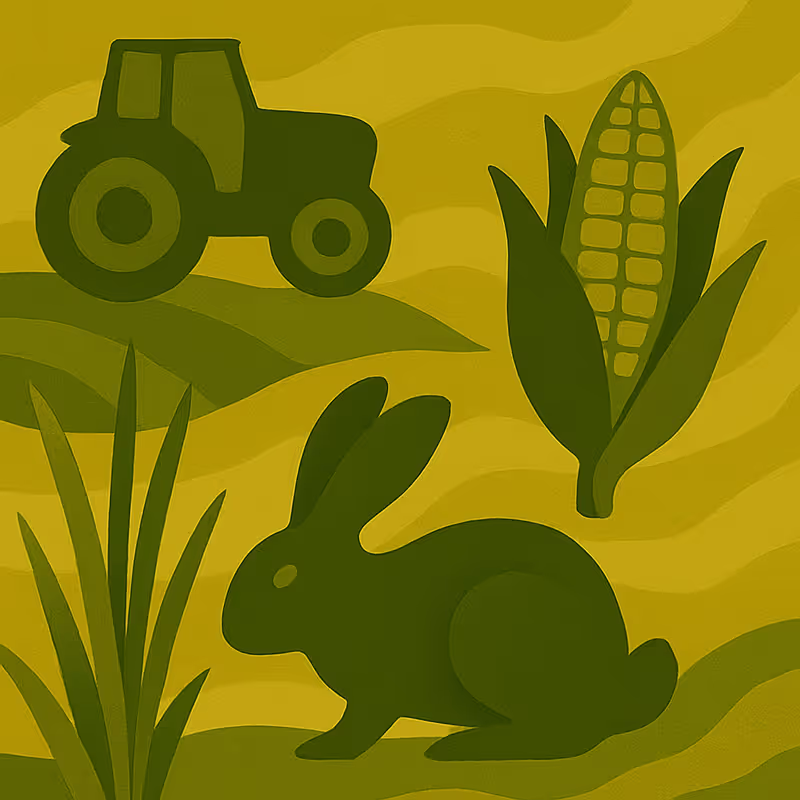Learning objectives:
- Describe how the global industrial food system contributes to biodiversity erosion
- Identify the ecological, social, and health impacts of industrial agriculture
- Critically assess the role of monocultures, livestock farming, commercial seeds and corporate control in driving biodiversity loss
What is industrial agricultural production?
In recent decades, the global industrial food system has sought to produce more and more food, at ever cheaper prices, through industrial agricultural production.
Industrial agriculture is characterised by intensive production of crops and animals at large scale. This involves the use of heavy machinery, modern irrigation systems, heavy use of synthetic fertilisers and pesticides on crops, or of antibiotics in animals, and monocultures over vast surfaces of land, to maximise yields.
2.1.1 Intensive animal farming
Intensive animal farming, also known as factory farming, consists of raising high numbers of animals in small spaces. The goal is to maximise profits through increasing production whilst lowering production costs.
This means that animals reared in intensive farming often do not have enough space, an appropriate diet, or the possibility of going outdoors, leading to animals raised in poor conditions to experience physical and emotional distress (D’Silva, et al., 2024).
Intensive livestock farming also harms nature and people outside the farm. It drives climate change through land use change and reared animals releasing methane, a type of greenhouse gas which is more potent at trapping heat than CO2. Animal waste pollutes waterways, being a major source of nitrogen excess in water bodies. This leads to the excessive growth of algae which depletes the water of oxygen, harming or killing fish and other types of aquatic life. Intensive livestock farming also poses public health risks such as zoonotic diseases, antimicrobial resistance, and respiratory problems.
2.1.2 Industrial crop production
In industrial crop production, the importance of biodiversity for food production is undervalued. Industrial crop production favours monocultures of a few high-yielding plant varieties on vast land surfaces.
Monoculture refers to the cultivation of a single crop on a large plot of land (Gladek, et al., 2017).
Even though there are over 50 000 species of edible plants globally and 6 000 plant species are cultivated for food, 60% of the world’s consumed calories come from just three sources: rice, wheat and maize (FAOa, n.d.). This is referred to as homogenisation of crops: the crops that are cultivated become more and more homogeneous, or alike.
The benefits and insights of local knowledge of plant and animal species have been lost to monocultures and crop homogenisation. This is in fact counter-productive because the productivity of food systems is not the same everywhere (Dawson, et al., 2019), as it depends on soil type, climate, pests, cultural practices.
Although being able to feed people using only three types of crops might seem efficient, it is not beneficial for biodiversity, or for humans - we need varied diets to thrive. These staple foods might fulfil caloric needs, but tend to be poor in the essential micro-nutrients that our bodies need to function properly and be healthy (UN Environment Programme, 2020).
Relying on and mainly consuming a limited number of staple crops has led to, globally, almost one in three people suffering from a form of malnutrition in 2022 (WHO, 2024), on top of one in twelve people facing hunger in 2024 (FAO, et al., 2025).
Industrial agriculture relies heavily on chemical pesticides. This heavy use of chemicals triggers adverse effects: natural pest control is reduced and the targeted organisms become resistant to pesticides, which traps farmers into a vicious cycle of increased pesticide use (European Environment Agency, 2023).
Chemical pesticides have a wide range of negative effects on biodiversity. They contribute to declines in animal populations and are a major cause of pollinator decline (European Environment Agency, 2023). Pollinators like bees, butterflies, birds and bats play a key role in food production as they transfer pollen from one flower to another, enabling crop reproduction.
Industrial crop food production tends to heavily use hybrid and genetically modified seeds. These tend to be sold by transnational businesses called agribusiness:
Hybrid seeds
Hybrid seeds are made by crossing two varieties of the same plant species to obtain a plant with specific desired traits. The result is uniform and productive but only for the first generation.
If you save seeds and sow them the next season, the traits of this second generation will be unpredictable. In practice, this can lock farmers into buying seed every year.
Hybrid varieties play a central role in intensive agriculture because of their high yields and genetic uniformity, which makes mechanisation easier.
However, their uniformity decreases local biodiversity and creates vulnerability for the farmer. A field of genetically similar hybrid plants may give high yields in good years, but is less resilient to the effects of climate change.
Genetically modified seeds
Genetically modified seeds have their DNA modified in the lab to carry specific characteristics such as herbicide resistance or pest resistance. Other modifications may include increased yield, resistance to drought, or nutritional value.
The genetic modification is often patented by companies, which gives them legal control over how the seeds are used. This usually means that farmers are not allowed to save and replant seeds from one season to the next, or freely exchange the seeds with other farmers.
In the EU, cultivation of genetically modified seeds is restricted, with only one genetically modified crop currently authorised for cultivation (a type of maize). Outside the EU, genetically modified seeds are widely used in intensive agriculture.
Genetically modified seeds contribute to biodiversity loss and undermine farmer autonomy:
- Widespread use of genetically modified crops can reduce genetic diversity and increase vulnerability to pests, diseases or climate stress;
- Corporate concentration in the agricultural sector means a handful of companies control not just the seeds but also the chemicals they depend on.

Reflection (5’)
Prompt: Watch this short video on the GMO story in only 3 minutes. Do you think it’s justified for big corporations to control farmers through patenting seeds?
But there are alternatives: open pollinated seeds. These seeds reproduce ‘true to type’: you can save them, sow them again next season, and you get plants much like the ones before. Over time, they adapt to local soils and climates. They carry genetic diversity, culture, and resilience. They can be either old or newly bred diverse varieties. Open-pollinated seeds are crucial for farmers’ autonomy, because farmers can freely save, use and exchange them.
Organic seeds
Organic agriculture refers to ‘an agricultural method that aims to produce food using natural substances and processes’ (European Commission, n.d.).
Organic rules in the EU ban genetically modified seeds and require the use of organic seeds where available. Both hybrids and open-pollinated seeds can be organic if grown under organic standards.
Open-pollinated seeds are crucial for biodiversity, local adaptation to climate change, and farmer independence. In practice, open-pollinated seeds are undervalued in the EU legislative framework, despite their importance for climate resilience and farmers autonomy.


















